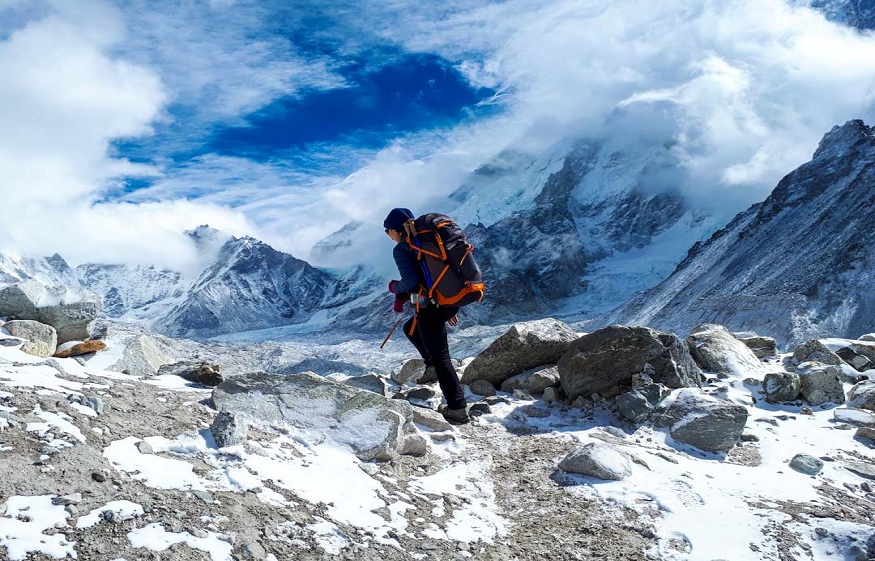Everest Base Camp Trek is one of the most rewarding and challenging trekking routes in the world. It draws thousands of adventurers each year, all who want to be at the base of Mount Everest, the highest peak in the world. The total distance, in miles and kilometers, is also an important consideration for those planning the trek, as many who attempt this trek focus on the higher altitude beauty and the physical demands of trekking in the Himalayas.
The total trekking distance from Lukla (the town at the gateway to the town) to Everest Base Camp and back is approximately 130 Kilometers (81 miles). Note that this is the round-trip distance, including the return to Lukla. The walk usually lasts from twelve to fourteen days, depending on your pace, acclimatization requirements, and weather conditions. Some trekkers whose goal is to spend more time resting at significant places in preparation for ASCENSION or a local sense of the place, may extend the time.
From Lukla, they will go up through Phakding and up to the main Sherpa town of Namche Bazaar. From Namche, trekkers follow the trail through Tengboche, Dingboche, Lobuche, and then Gorak Shep before the base camp. The one-way trek to Everest Base Camp is around 60 kilometers (37 miles) from Lukla. However, this distance may vary based on the route selection and the number of detours taken for acclimatization hikes.
There are several significant elevation points along the trek to Base Camp. Lukla is at an altitude of roughly 2,860 meters (9,383 feet), and Everest Base Camp is at 5,364 meters (17,598 feet) in the Khumbu region of Nepal, an elevation of more than 2,500 meters (8,200 feet). Designed for the more serious trekker, the trail crosses lush forests and alpine meadows, only to open up to more barren, rocky sections the closer you get to the base camp. Head towards Base Camp involves a lot of ascent, so this particular leg of the journey is all the way up.
The distance of the trek isn’t linear mileage. It’s also about altitude gain and how the body copes with the thinning air. Altitude can also make the trek feel longer, since with an ascent comes greater fatigue. Trekkers don’t generally move in a straight line, instead taking regular breaks and detours to allow for acclimatization.
The return trip from Everest Base Camp to Lukla is usually quicker, as the main path is downhill, but trekkers still need to watch their step, especially in the steeper sections. The descent usually takes around 4 – 5 days and is roughly 60 km (37 miles).
Note that the distance trekked each day will also vary considerably based on altitude, weather, and the physical condition of the trekkers. Most trekkers trek about 8-12 kilometers (5-7.5 miles) per day, with some longer days, particularly near Base Camp. This route is well-trodden, but it’s helpful to stay aware of the evolution of the conditions and to make sure you rest enough and acclimatize properly to reduce the principal risk of altitude sickness.
Finally, the Everest Base Camp Treks is long and covers a distance of around 130 km (81 miles) on the whole trek while covering around 60 km (37 miles) for a way trek. The odyssey isn’t merely cumbersome, as the journey isn’t judged on the distance; it is due to the high altitudes and hard mileages, which make it more memorable and an experience of a lifetime. With proper fitness, acclimatization, and pacing, the trek can be completed with nothing but the fondest memories of the journey.
Everest Base Camp Trek Distance 101
An Adventure of a Lifetime: Everest Base Camp Trek. The distance is one of the first things that people want to know about when planning the trek, as how far you will be travelling can go a long way to preparation and setting expectations for the journey. The mountain trek begins in Lukla, a small town in Nepal, and traverses several villages, rugged trekking trails, and a high-altitude environment, until finally arriving at Everest Base Camp (EBC) at an elevation of 5,364 meters (17,598 feet). The total trail distance from Lukla to Base Camp and back is around 130 kilometers (81 miles). This distance is usually covered in 12 to 14 days, including acclimatization time at different stops. The challenge of the trek lies not simply in its length but in its gain in elevation and the effects of trekking at altitude, which means acclimatization is essential. The terrain also varies widely, from vibrant forests at lower altitudes to rocky trails in the vicinity of Base Camp. Therefore, understanding the distance in miles and kilometers will guide you to pace yourself and establish your daily uphill trekking plan.
Total Trek Distance: Miles or Kilometers
Mount Everest base camp Trek Distance (Miles & Kilometers) When preparing the Everest Base Camp Trek, it is vital to realize the total trekking distance in miles and kilometers. Lukla to Everest Base Camp and back: approximately 130 km (81 miles) round trip. This distance might sound intimidating, but trekkers typically cover 8 to 12 kilometers (5 to 7 miles) every day, depending on the terrain and their speed. The journey to Base Camp is roughly 60 kilometers (37 miles) one-way. Though the trek to Base Camp is a gradual ascent, the return trip is typically faster because you are descending. Daily walking distance varies depending on the trekking itinerary, with some shorter days to acclimatize and other longer days to cover the distance comfortably. Stopping at major villages such as Namche Bazaar, Tengboche, and Dingboche, the trek is essential for acclimatization. The distances between each village are not too demanding, but trekkers should consider the elevation gain and their risk of altitude sickness. Also, knowing the total length of the trek helps you to visualize how much distance you cover per day, allowing you to plan out your energy and sleep accordingly.
The trek distances — Day-by-Day Breakdown
The Everest Base Camp Trek usually extends over 12 to 14 days, with trekkers covering distant miles on each passing day. The hike starts from Lukla to Phakding, Namche Bazaar, Tengboche, Dingboche, Lobuche, Gorak Shep, and ultimately the Everest Base Camp. Here’s a rough breakdown of miles traveled day by day:
Day 1: Lukla to Phakding – 7.5 km (4.7 miles)
Day 2: Phakding to Namche Bazaar – 10 km (6.2 miles)
Day 3: Acclimatization in Namche Bazaar (Rest Day) – no trekking distance but optional hikes
Day 4: Namche Bazaar to Tengboche – 10 kilometers (6.2 miles)
Day 5: Tengboche to Dingboche — 12 kilometers (7.5 miles)
Day 6: Rest day Dingboche (Acclimatization, optional hikes) — No trekking distance
Day 7: Dingboche to Lobuche– 12 kilometers (7.5 miles)
Day 8: Lobuche to Gorak Shep – 4.5 kilometers (2.8 miles)
Day 9 Gorak Shep to Everest Base Camp – 3.5 km (2.2 miles)
Day 10: Retrace to Gorak Shep, then continue to Pheriche — 13 kilometers (8 miles)
Day 11–12: Return to Lukla – 25 kilometers (15.5 miles)
This day-by-day breakdown enables trekkers to properly pace themselves and plan adequate rest and acclimatization, both of which are crucial in this high-altitude environment.
Distance and Elevation Gain: Lukla to Phakding
Everest Base Camp The trek begins at Lukla and reaches Phakding, approximately 7.5 kilometers (4.7 miles). Though this first leg is relatively short, it provides a gradual introduction to the altitude and terrain. Lukla, at 2,860 meters (9,383 feet), is a frequent starting point for trekkers. From here, the trail drops a little and then follows the Dudh Kosi River through the small Sherpa villages. The trail offers a variety of forest paths and suspension bridges as trekkers cross through Cheplung and other smaller settlements. The elevation gain along this part is relatively lo,w with Phakding located at 2,610m (8,563 ft). The altitude difference is only about 250 meters (820 feet), but trekkers should pace themselves, as even this modest elevation can begin to hit some people. The distance and relatively light gain are a good introduction to the trek, and trekkers can hit their stride in walking and acclimatizing on the first day.
Distance and Terrain from Phakding to Namche Bazaar
The distance between Phakding and Namche Bazaar is around 10 kilometers (6.2 miles), making it one of the most challenging and beautiful sections of the trek during its initial stage. Through deep forests of pine and rhododendron, the trail snakes its way upward (past small Sherpa settlements, like Jorsale, and the now-infamous Tenzing-Hillary Bridge) before the steep slog to Namche Bazaar. At this point, there is quite a big altitude gain from Phakding (2,610 m / 8,563 ft) to Namche Bazaar (3,440 m / 11,286 ft) with a distance of 830 m (2,723 ft). This steep climb is challenging, especially for hikers nearing the last leg before Namche. Trekkers enjoy panoramic views of surrounding Himalayan peaks, and they catch glimpses of Mount Everest itself as they approach Namche, a thrilling milestone on the trip. The trail is varied, with some areas of gentle slope and others requiring steeper work, so it’s best to proceed at a comfortable pace and rest when you need to. While challenging, this portion of the trek introduces the climber to the terrain in the Everest region.
Trek Distance and Challenges: Tengboche to Dingboche
Staying in Dingboche is a key part of the Everest Base Camp trek. These two villages are about 12 km (7.5 miles) apart. This section of the hike is potentially a tough one since the incline is constant and the altitude is higher. Tengboche is located at 3,870 meters (12,697 feet), and Dingboche is at 4,410 meters (14,469 feet), making the gain for trekkers about 540 meters (1,771 feet). The terrain includes rhododendron and pine forests, and alpine meadows near Dingboche.
The distance is not too far, but trekkers must be cautious about the altitude. The higher up you go, the thinner the air, so the trek can be more arduous. A popular acclimatization spot, Dingboche is at high altitude, and it is important to use it to rest while the body acclimatizes. It is not just about the distance; it is offering your body time to adapt. The climb to Dingboche is relatively gentle, but trekkers should rest regularly, keep hydrated, and pay attention to their bodies to prevent altitude sickness from setting in.
Distance and elevation gain: Dingboche to Lobuche
Himalayan Base Camp Trek The distance from Dingboche to Lobuche is roughly 12 kilometers (7.5 miles). Dingboche is located at 4,410 meters (14,469 feet) and Lobuche at 4,910 meters (16,109 feet), so trekkers will ascend approximately 500m (1,640ft) in altitude.
With some gradual ascents that challenge your endurance, the terrain is a combination of rocky paths and small boulders. As you make your way through this leg of the trip, you’ll traverse pastures interrupted by the occasional yak herder, gradually gain in altitude, and depart the greenery for the more desolate alpine spaces. Reality sinks in as the altitude increases here, and trekkers are likely to experience the effects of the decrease in oxygen levels. The dry, dusty air of this region can make the climb all the more strenuous, so proper hydration and slow pacing are key.
The Lobuche village is also beautifully used as an acclimatization stop, allowing you to enjoy the stunning views of Ama Dablam, Nuptse, and Pumori. But it is important to stop here and take it easy. The climb up to Lobuche becomes a critical stage as trekkers have now entered more than 4,900 meters (16,076 feet), and the true stress of altitude begins to work on your body.
Extreme Altitude Trekking: Lobuche to Gorak Shep
The path from Lobuche to Gorak Shep is one of the last, high-elevation pushes before you arrive at the Everest Base Camp. It’s about 4.5 kilometers (2.8 miles), which may not sound like much, but you’ll be hiking at 5,140 meters (16,864 feet)․․. That’s a strenuous altitude that easily leads to fatigue and shortness of breath, even on relatively flat terrain.
It is a rocky, sometimes windswept landscape with sparse vegetation. The only downside is that as you climb up from Lobuche, the weather is that much worse, and the altitude means that the air is that much thinner. This part of the trek sees many trekkers start to experience the symptoms of altitude sickness, which means being aware of your body’s response and pacing yourself here is paramount.
The 4.5 kilometers seem to take much longer in the extreme conditions and thin air, and it usually takes three to four hours to complete. Gorak Shep is the last stop before Base Camp, and trekkers often feel both spent and ecstatic upon arrival. Out there is the starkest landscape, and it bears down on you with the weight of the extreme environment. It’s an important place to rest since the next leg is the trek to Everest Base Camp, the destination where trekkers need to conserve energy.
Final Stretch: Gorak Shep to Everest Base Camp
Everest Base camps The final stretch, from Gorak Shep on the trail to Everest Base Camp, is roughly 3.5 kilometers (2.2 miles), but it’s one of the most venerated and emotional stretches of the climb. This leg carries trekkers through dry landscapes of rocky paths and glacial moraine. At higher altitudes still, the air becomes even thinner, and hikers are required to take more frequent rest breaks to catch their breath.
The distance is short, but the altitude (about 5,364 meters / 17,598 feet) and the rugged terrain make for a challenging segment for many. The journey culminates at Base Camp, where trekkers now marvel at views of Mount Everest, Khumbutse, and Nuptse — and the occasion is often a tearful one after weeks of intensive, backbreaking trekking. The trek is also a time to pause and consider the significance of being at the foot of the planet’s highest peak.
The senses of euphoria and accomplishment are overwhelming, though, and outweigh the physical ramifications, which are beyond intense. Trekking to the Base Camp is a great experience, so after enjoying the Base Camp, trekkers will start to return.
Return Journey: Departures for Going Down
The trek from Everest Base Camp trek cost back to Lukla is usually faster than the ascent, but it’s an important part of the trek nonetheless. The daily distances are similar to the first half of the trek, although the descent is generally much quicker. After Gorak Shep, trekkers will go back to Lobuche, and return to Dingboche or Tengboche, and finally to Namche Bazaar, where you can take a rest before the final ascent.
This descent takes around 3 to 4 days, covering approximately 60 kilometers (37 miles) total. Despite being quicker, descending can be equally grueling on the body, what with the steep land and the impact on your joints, in particular your knees. Trekkers need to be cautious and take their time, so that they do not hurry back too soon.
In Summary: What is the Total Distance?
Around 130 kilometers (81 miles) round-trip from Lukla, trek to Base Camp Mount Everest and back. The trip is broken down into manageable portions, varying by difficulty level based on elevation, terrain, and physical fitness level. Major waypoint stops en route to Base Camp include Namche Bazaar, Tengboche, Dingboche, Lobuche, and Gorak Shep. The mileage is considerable, but what makes this trek so arduous are the physical demands of altitude and terrain. Knowing the distances and planning accordingly will enable trekkers to successfully complete this world-class adventure.Need assistance planning your trek? We’re just an email away at info@sherpaexpeditiontrekking.com or message us on WhatsApp at +977 9866007038.




